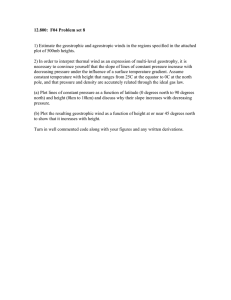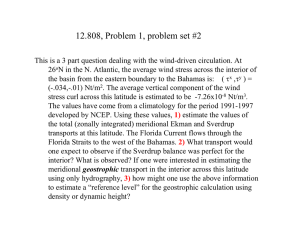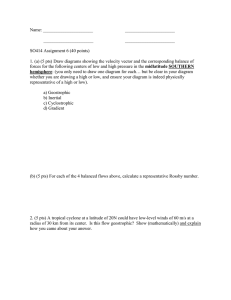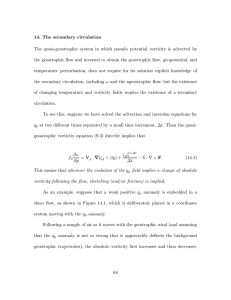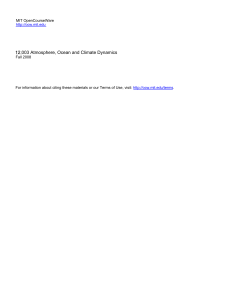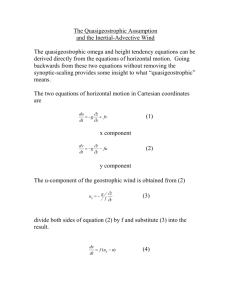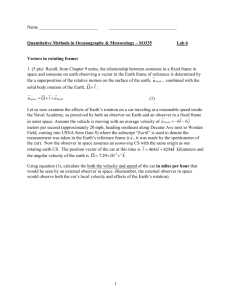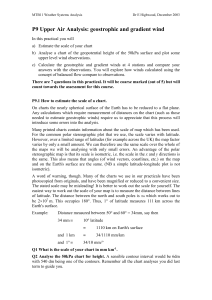12.307 Weather and Climate Laboratory MIT OpenCourseWare Spring 2009
advertisement
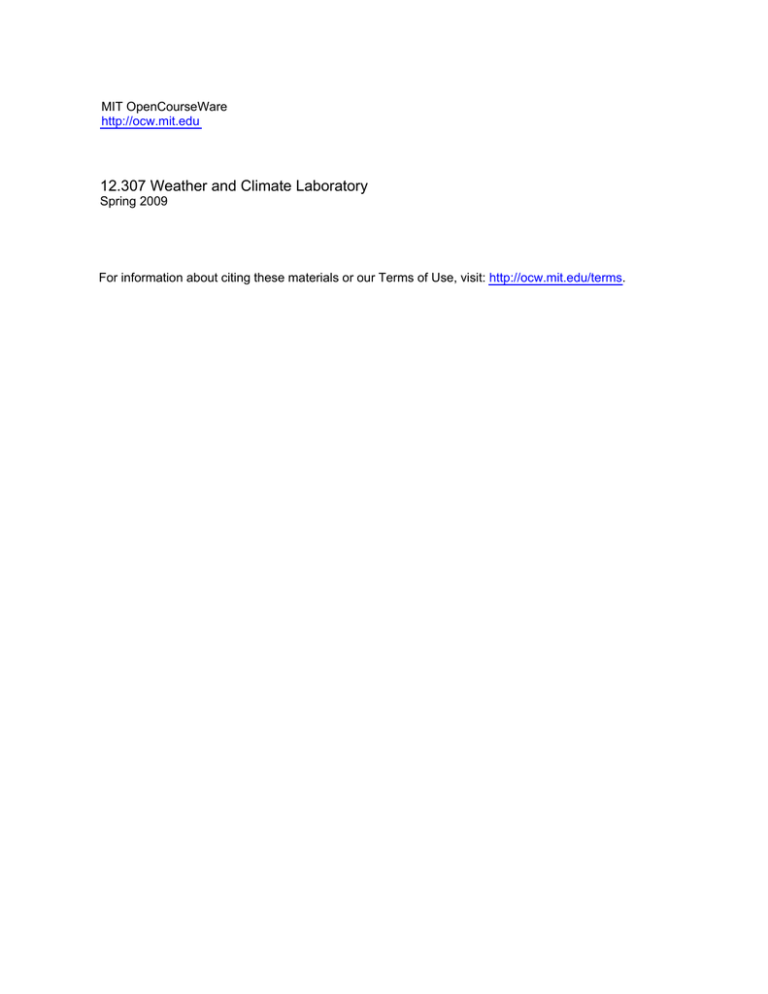
MIT OpenCourseWare
http://ocw.mit.edu
12.307 Weather and Climate Laboratory
Spring 2009
For information about citing these materials or our Terms of Use, visit: http://ocw.mit.edu/terms.
Geostrophic balance
John Marshall, Alan Plumb and Lodovica Illari
March 4, 2003
Abstract
We describe the theory of Geostrophic Balance, derive key equations and discuss
associated physical balances.1
1
Geostrophic balance
If the flow is such that the Rossby number is small – Ro ¿ 1 – where
Ro =
U
fL
(1)
(here U is a typical horizontal current speed, f is the Coriolis parameter and L is a typical
horizontal scale over which U varies), then the Coriolis force is balanced by the pressure
gradient force in the horizontal component of the momentum equation, which reduces to:
fb
z × u+
1
∇p = 0
ρ
(2)
where b
z is a unit vector in the vertical direction.
In situations where (as is always the case) Eq.(2) is only an approximate balance, the
velocity u defined by (2) – involving only the horizontal components of u – is known as the
geostrophic wind (or current). Rewriting Eq.(2), we can define the geostrophic wind (since
b
z×b
z × u = −u) as
1
b
ug =
(3)
z × ∇p ,
ρf
or, writing out its Cartesian components,
1 ∂p
;
ρf ∂y
1 ∂p
=
.
ρf ∂x
ug = −
vg
1
(4)
1 GEOSTROPHIC BALANCE
2
Figure 1: Schematic of two isobars on a horizontal surface. The magnitude of u increases as the
siobars become closer together.
We see from Eq.(2) that the geostrophic flow is normal to the pressure gradient: i.e. along
isobars (lines of constant pressure) and its speed is proportional to the pressure gradient.
Consider Fig.1, the curved lines show two isobars on which pressure has the constant values
p and p + δp. Their separation is δs. From Eq.(3), the flow speed is
|ug | =
1
1 δp
|∇p| =
.
ρf
ρf δs
Since δp is constant along the flow, |ug | ∝ (δs)−1 : the flow is strongest where the isobars
are closest together. Since the geostrophic flow cannot cross the isobars, the latter act like
banks of a river, causing the flow to speed up where the river is narrow and slow down where
it is wide.
As shown in Fig.2, the flow is (in the northern hemisphere) anticlockwise (cyclonic)
around a low pressure center, and clockwise (anticyclonic) around a center of high pressure.
(“Cyclonic” means in the same sense as the vertical component of the Earth’s rotation,
and “anticyclonic” the opposite. So, in the southern hemisphere where f < 0, the flow
is clockwise, but still cyclonic, around a low pressure center.) This rule is summarized in
1
Notes to accompany 12.307: Weather and Climate Laboratory. For a more detailed description see notes
on 12.003 web page here: http://paoc.mit.edu/labweb/notes.htm
1 GEOSTROPHIC BALANCE
3
Figure 2: Geostrophic flow around (left) a low pressure center and (right) a high pressure center.
(Northern hemisphere case, f > 0.) The effect of Coriolis delecting flow ‘to the right’ is balanced by
the horizontal component of the pressure gradient force, − 1ρ ∇p, directed from high to low pressure.
Figure 3:
Buys-Ballot’s law:
If you stand with your back to the wind in the northern
hemisphere, low pressure is on your left.
We now consider pressure coordinate versions of the geostrophic and continuity equations
which allow some simplifications (with regard to density variations) to be made.
1.1
The geostrophic wind in pressure coordinates
In order to apply the geostrophic equations to atmospheric observations and particularly
upper air analyses (see below), we need to express them in terms of height gradients on a
pressure surface, rather than, as in Eq.(4), of pressure gradients at constant height. Consider
Fig.3. The figure depicts a surface of constant height z0 , and one of constant height p0 , which
intersect at A, where of course pressure is pA = p0 and height is zA = z0 . At constant height,
1 GEOSTROPHIC BALANCE
4
the gradient of pressure in the x-direction is
µ
∂p
∂x
¶
=
z
pC − p0
δx
where δx is the (small) distance between C and A. Now, the gradient of height along the
constant pressure surface is
µ ¶
∂z
zB − z0
=
.
∂x p
δx
Since zC = z0 , and pB = p0 , we can use the hydrostatic balance equation Eq.(??) to write
pC − p0
pC − pB
∂p
= +gρ
=
=−
zB − z0
zB − zC
∂z
Therefore (and invoking a similar result in the y-direction), it follows that
µ
µ
∂p
∂x
∂p
∂y
¶
z
¶
z
µ
¶
∂z
= gρ
;
∂x p
µ ¶
∂z
= gρ
.
∂y p
Therefore Eq.(3) becomes, in pressure coordinates,
ug =
g
zbp × ∇p z ,
f
(5)
where zbp is the upward unit vector in pressure coordinates and ∇p denotes the gradient
operator in pressure coordinates. In component form,
¶
µ
g ∂z g ∂z
,
.
(ug , vg ) = −
f ∂y f ∂x
(6)
Note that, like p contours on surfaces of constant z, z contours on constant p are streamlines
of the geostrophic flow. Note that, in pressure coordinates, the geostrophic wind is, as before,
nondivergent if f is taken as constant:
∇ · ug =
∂u ∂v
+
=0.
∂x ∂y
Let’s now look at some synoptic charts to see some of these ideas in action.
1 GEOSTROPHIC BALANCE
5
Figure 4: 500mb wind and geopotential height field on October 9th 2001. The wind blows
away from the quiver: one full quiver denotes a speed of 5ms−1 , one half-quiver a speed of
2.5ms−1 . The geopotential height is in meters.
1.2
Highs and Lows; synoptic charts
Fig.4 shows the height of the 500mb surface (in geopotential metres, contoured) plotted with
the observed wind vector (one full quiver represents a wind speed of 5 ms−1 ). Note how the
wind blows along the isobars and is strongest the closer the isobars are together - see the
schematic diagram in Fig.2. At this level, away from frictional effects at the ground, the
wind is close to geostrophic.
1 GEOSTROPHIC BALANCE
6
Figure 5:
1.3
Visualizing geostrophic balance on the sphere
To get a feel for geostrophic balance on the sphere it is very useful to consider a ring of air
moving eastward at speed u relative to the underlying rotating earth.
There is a centrifugal acceleration directed outwards perpendicular to the earth’s axis of
rotation, the vector A sketched in fig(5):
(u + Ωr)2
u2
V2
=
= Ω2 r + 2Ωu +
(7)
r
r
r
Here V is the ‘absolute’ velocity the fluid has viewed from an observer fixed in space looking
back at the earth. Let’s now consider the terms in turn:
• Ω2 r - this is the centrifugal acceleration acting on a particle fixed to the earth. As
discussed above, this acceleration is included in the gravity which is usually measured
and is the reason that the earth is not a perfect sphere.
2
• 2Ωu + ur - the additional centrifugal acceleration due to motion relative to the earth.
Note that if Ωur << 1, we may neglect the term in u2 . For the earth Ro = Ωur ∼ 0.02
and so the 2Ωu term dominates. It is directed outward perpendicular to the axis of
rotation and can be resolved: perpendicular to the earth’s surface - vector B in the
diagram - and parallel to the earth’s surface - vector C in the diagram.
Component B changes the weight of the ring slightly - it is very small compared to g,
the acceleration due to gravity, and so unimportant.
1 GEOSTROPHIC BALANCE
7
Figure 6:
Component C, parallel to the earth’s surface, is the Coriolis acceleration:
2Ω sin ϕ × u
So there is a centrifugal force directed toward the equator because of the motion of
the ring of air relative to the earth. It is this force that balances the pressure gradient
force associated with the sloping isobaric surfaces induced by the pole-equator temperature
gradient.
Let’s postulate a balance between the Coriolis force and the pressure-gradient force di
rected from equator to pole associated with the tilted isobaric surfaces - see Fig.6.
∂p
ρadϕdz × 2Ω sin ϕu = − dϕdz
| {z } | {z }
∂ϕ
| {z }
mass
acceleration
p_grad
Introducing a coordinate y which points northwards on the earth’s surface, dy = adϕ, the
above reduces to:
fu +
1 ∂p
=0
ρ ∂y
(8)
where f = 2Ω sin ϕ is the Coriolis parameter.
This is just one component of the geostrophic relation, Eq.(4), between pressure gradient
forces and Coriolis forces.
